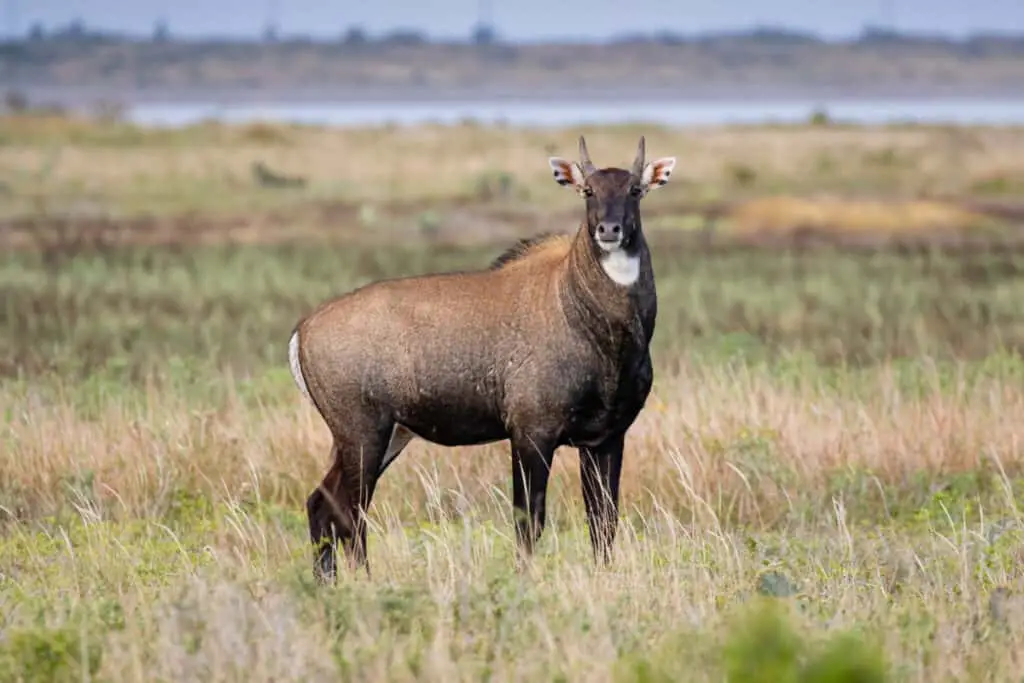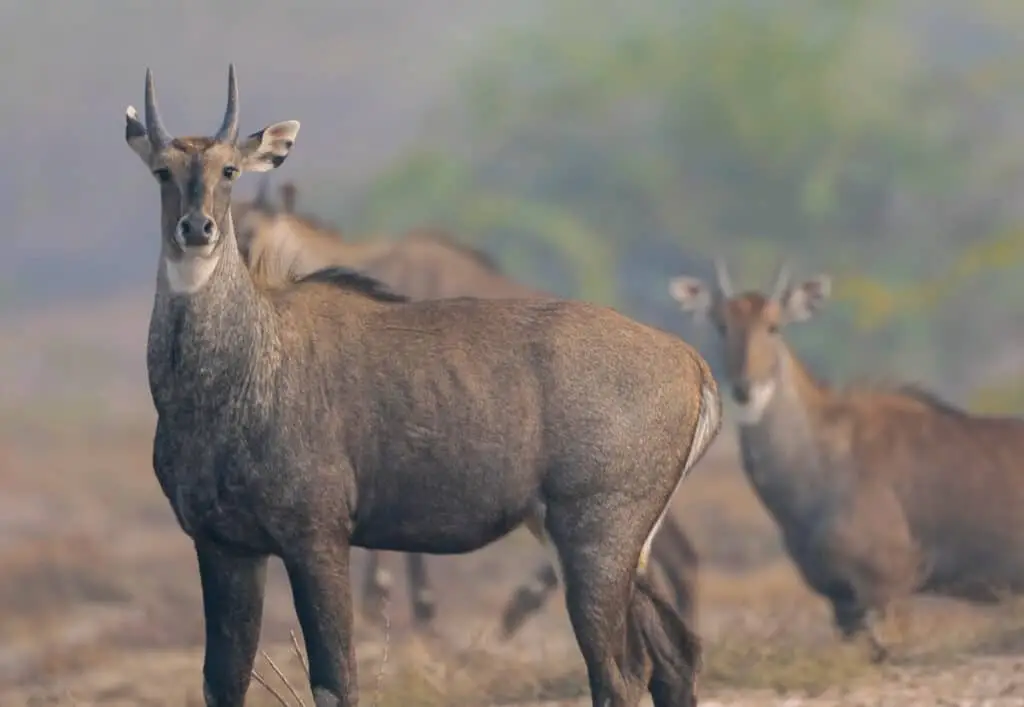Nilgai, also known as the blue bull or Boselaphus tragocamelus, is a large antelope species native to the Indian subcontinent. It is one of the most iconic animals in India and holds important cultural significance for many communities.
The nilgai’s name comes from the Hindi words ‘nil,’ meaning blue, and ‘gai,’ meaning cow, due to its distinctive bluish-gray coat. They are typically found in open grasslands, shrublands, and agricultural fields across India, Pakistan, Nepal, and Bangladesh.
Despite their widespread distribution and importance in Indian culture, little is known about the ecology and behavior of this species. In recent years, however, researchers have begun to shed light on various aspects of the nilgai’s biology and conservation status.
This article aims to provide an overview of what we currently know about these fascinating creatures.

Physical Characteristics Of Nilgai
Nilgai, also known as blue bulls, are large antelopes native to the Indian subcontinent. They possess a distinctive appearance with their bluish-gray coat and white throat bibs.
Males can weigh up to 240 kg while females weigh around 120 kg. These herbivores have evolved prominent ridges on their noses that function as cooling mechanisms in hot environments.
Behavioral adaptations of nilgais include living in small herds consisting of one dominant male and several females and young ones. The males engage in combat during mating season by using their sharp horns, which they use for protection against predators like tigers and leopards.
Nilgais are highly adaptable animals that thrive in arid regions where other herbivores might struggle due to lack of water availability or vegetation resources. Their evolutionary history dates back to over five million years ago when they first appeared in the fossil record alongside other ruminants such as deer and cattle.
Habitat And Distribution
The nilgai, also known as the blue bull, is primarily found in India and Nepal. They have a wide geographical range that includes grasslands, shrublands, and forests.
Nilgais are herbivorous animals and consume a variety of plants such as leaves, fruits, flowers, and seeds.
In terms of ecological niche, nilgais play an important role in maintaining the balance between vegetation growth and consumption by grazing on various plant species.
They are also preyed upon by several predators like tigers and leopards.
Due to their adaptability to different habitats and low level of dependence on specific food sources, nilgais have been successful in surviving in changing environments and continue to thrive across their geographical range.
Diet And Feeding Behavior
The nilgai, also known as the blue bull, is a herbivorous mammal that feeds primarily on grasses and leaves. Their diet consists of various types of vegetation such as alfalfa, Bermuda grass, and acacia leaves. As foraging strategies vary among different herbivores, the nilgai’s feeding behavior is categorized as being intermediate between grazers and browsers.
Given their nutritional requirements, it is important for the nilgai to consume a variety of plants to obtain all necessary nutrients. They have been observed to selectively feed on certain plant parts depending on seasonal availability and nutrient content.
Additionally, during drought conditions or scarcity of food sources, they may resort to consuming less preferred plants or even bark from trees. This flexibility allows them to survive in changing environments and adapt to seasonal fluctuations in food availability.
Overall, understanding the dietary habits and foraging strategies of the nilgai can aid in conservation efforts by ensuring adequate food resources are available in their natural habitats. Conservation efforts must take into account the nutritional needs and feeding behaviors of wildlife to ensure their continued survival and well-being. Providing adequate food resources in their natural habitats is crucial in protecting and preserving these species for generations to come.
Social Behavior And Reproduction
Mating rituals among nilgais are not well documented in scientific literature. However, observations suggest that male nilgais engage in ritualized behavior during breeding season to attract females.
This includes displays of dominance such as head-butting and neck-wrestling with other males, vocalizations, and spraying urine on themselves. These behaviors serve to establish social hierarchy and indicate fitness for mating.
Nilgais live in groups consisting of females and their young along with a few adult males. The group dynamics vary depending on the size of the herd and availability of resources.
In smaller herds, there is less competition for resources leading to more relaxed social interactions while larger herds exhibit more complex social hierarchies. Females generally stay within their natal herd but may move between groups occasionally.
Male offspring leave the herd when they reach sexual maturity whereas female offspring remain part of the group for life unless they switch to another herd or create their own group with other females.
Overall, understanding nilgai’s social behavior and reproductive strategies can provide insight into how this species adapts to its environment and copes with various ecological challenges it faces over its range.
Conservation Status And Threats
The nilgai, also known as the blue bull, is classified as a species of least concern by the International Union for Conservation of Nature (IUCN). Despite their relatively stable population size, they continue to face various threats.
One significant threat that affects them is habitat loss due to human encroachment and agricultural expansion. The conversion of grasslands into croplands has resulted in a decline in available grazing areas for nilgais.
Another major threat to the nilgai’s survival is hunting for meat and sport. Although it is illegal under Indian law to hunt these animals without permission from the government, poaching still occurs.
To mitigate these threats, conservationists have suggested several measures such as community involvement in conservation efforts and protecting habitats through strict enforcement of laws against poaching. Community members can participate in monitoring activities aimed at gathering information about the distribution and abundance of wild populations while also spreading awareness about the importance of conserving this species.
By working together with governments and other stakeholders, we can ensure that future generations will be able to appreciate the beauty of this majestic animal in its natural habitat.
Future Research Directions
Genetic analysis of nilgai populations can provide valuable insights into their evolutionary history, population structure, and conservation genetics. Studying the genetic diversity and gene flow among different subpopulations can help identify potential barriers to gene flow and inform management strategies for maintaining connectivity between these groups. Additionally, identifying regions of the genome under selection in response to environmental pressures such as climate change can shed light on the adaptive potential of nilgai populations.
Climate change adaptation is a critical area that requires further research regarding nilgais. Understanding how this species will respond to changing climatic conditions is vital for developing effective conservation strategies. As temperatures increase, it is likely that nilgais’ range may shift or contract, which could impact their distribution and interactions with other species.
Future studies should focus on:
- investigating the physiological responses of nilgai to increasing temperatures and determining whether they have the capacity to acclimate or adapt over time.
- modeling future scenarios using climate data, to aid in predicting how changes in temperature and precipitation patterns might affect nilgai populations over time.

Conclusion
Nilgai, also known as blue bulls, are large antelopes native to the Indian subcontinent. These animals have a distinct bluish-gray coat with white markings and long, slender legs that allow them to run at high speeds of up to 50 mph.
They prefer open grasslands and forested areas for their habitat and feed on various types of vegetation. Nilgai’s diet consists mostly of leaves, flowers, fruits, and grasses. They use their strong jaws to crush tough stems and chew food thoroughly before swallowing.
Nilgai live in small herds consisting of one dominant male accompanied by several females and young offspring. Mating occurs between December and June when males actively compete for access to receptive females.
Despite being widespread throughout India, nilgai populations face threats from habitat loss due to human encroachment and poaching for meat and hide. Conservation measures such as protected areas, controlled hunting programs, and community-based conservation initiatives can help mitigate these threats.
In conclusion, the physical characteristics, feeding behavior, social structure, distribution range, conservation status, and future research directions make the nilgai an interesting subject for further study. Efforts must be taken to conserve this species through sustainable management practices while addressing challenges like habitat fragmentation and human-wildlife conflict.
Future research should focus on understanding nilgai’s ecological role in maintaining ecosystem health while developing effective strategies for population monitoring and disease prevention. The continued efforts towards conserving this magnificent animal will ensure its survival for generations to come.

